Luka Modric, the maestro of Real Madrid‘s midfield for over a decade, has quietly played his final game for the Spanish giants during the FIFA Club World Cup semifinal at MetLife Stadium. Though the match ended in defeat against PSG, it marked the end of an unparalleled chapter in Madrid’s history.
Coming on in the 64th minute, Modric couldn’t change the tide, and as the final whistle blew, he bowed out without the fanfare often reserved for legends. But that understated exit felt fitting for a player who always prioritized team over individual glory.
In 13 seasons, Modric collected an unmatched 28 trophies, becoming the most decorated player in Real Madrid‘s storied history. His stats: 597 appearances, 43 goals, and titles that include 6 Champions Leagues, 4 La Liga titles, 5 Club World Cups, and the coveted Ballon d’Or in 2018—the only player in recent memory to break the Messi-Ronaldo duopoly. He was also one-third of the legendary midfield trio Modric–Kroos–Casemiro, often called the “Bermuda Triangle” for how they dismantled Europe’s best.
Now 39, Modric will join AC Milan this August on a free transfer. The Italian side confirmed a one-year deal with an option for another, with a salary of €3–3.5 million per season. Coach Massimiliano Allegri welcomed the Croatian legend, calling him “a leader who needs no introduction.”
Milan sees Modric not just as a player, but a symbol—an anchor of experience and spirit to guide the club’s younger generation in a rebuilding phase. As he transitions to Serie A, Modric carries not just his medals, but a legacy of intelligence, resilience, and enduring brilliance.

